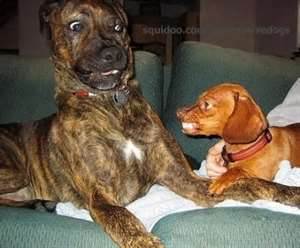01529 304273 - [email protected]
 Many people can, or think they can, assess the mood their pet is in without thinking about it, but assessing the mood of other dogs, or your own in a strange situation can sometimes be tricky. No matter the size of your dog, you do not want it to cause injury or distress to another person or dog, so being able to tell how he or she is feeling is important.
Many people can, or think they can, assess the mood their pet is in without thinking about it, but assessing the mood of other dogs, or your own in a strange situation can sometimes be tricky. No matter the size of your dog, you do not want it to cause injury or distress to another person or dog, so being able to tell how he or she is feeling is important.
This brief guide gives a few postures to look out for, and gives some advice about children and dogs.
Scarily enough:
• 90% of dog bites happen to people who know the dogs
• Most of the dogs that bite are the family pets
• 60% to 70% of dog bites are to children or the elderly
• 40% of the bites to children result in loss of facial tissue (lips, cheek etc.)
Personally I am appalled by the media who seem to think small dogs being aggressive, growling and going for people is entertaining because they are so small, but it is a fact that more dog bites come from small dogs than from big dogs. The University of California did a study and found that dogs under 16 pounds are more likely to snap at people. My personal feeling is that “SMALL DOG OWNERS” do not perceive their dogs as being very dangerous. The majority of large dog owners make some attempt at controlling aggression problems, (even if it’s just giving the dog away or having it put to sleep). While the small dog owners often tend to ignore the problem and feel that their little terrier is just being cute when it growls at kids or guests that try and sit on the couch next to it. The fact is small dogs can bite small children in the face.
Happy Dogs
• Relaxed ears and a wagging tail
• A dog that wants to play may jump around in front of you or roll on his back.
Attention Seeking
• Attention-grabbing tricks: sitting next to you, putting their face close to yours or in your lap, barking, howling and patting you with a paw.
• Don’t just ignore your dog; they can become destructive or bad-tempered.
Bad-tempered and Angry Dogs
• Growling or baring its teeth – they might feel threatened and want to be left alone. Keep your distance from any dog in this mood.
• Always keep calm and walk away slowly – don’t run.
• Keep your hands in your pockets or cross your arms.
• Try not to look directly at the dog.
Ill Dogs
• Droopy ears and tail
• Less energetic and ‘bouncy’ than usual, even grumpy.
• May also lose interest in food.
• A dog can show illness in many different ways, if in doubt talk to your vet.
Frightened Dogs
• Flattened ears, lowered tail or tail between their legs.
• Hiding behind their owner, whining or growling – move away from the dog.
• If your own dog is scared, reassure them; stay calm, speak softly and move away from whatever is making them nervous.
Safety around strange dogs
We’ve all seen dogs out and about that look friendly, but it’s always important to take care with dogs you don’t know.
• Never rush up to a strange dog or shout loudly near him – this will scare them and they may react angrily.
• If you can see the owner and want to pet the dog – ask first, then hold out your hand and let the dog come to you.
• Don’t stare into a dog’s eyes – as this can be seen by the dog as threatening If a dog growls at you or seems unfriendly, just calmly walk away.
• Don’t disturb a dog if he’s eating, drinking or has been tied up – and always let sleeping dogs lie.
Keeping children safe around dogs
Teach your child to be calm and careful around dogs to ensure they stay safe, even if you have no intention of keeping a dog yourself, it is likely they will come into contact with dogs when out playing, or at friends and relatives homes.
• Children should never go near dogs they don’t know and only pat or play with a dog if they have asked the owner.
• Don’t let your children tease a dog or play too roughly with him.
• Teach your dog not to jump up at them or be too boisterous as this can lead to accidents.
• Tell them never to go near or disturb a dog that is sleeping, eating, ill or injured as dogs may react badly.
Never leave young children unsupervised with any dog, even if it’s only for a few minutes.
• Make sure you socialise your puppy properly with children and teach him how to behave, even if you don’t know any young people. It’s unlikely your dog will never a meet a child it its entire life! Doing this will ensure you have a friendly adult dog that is safe to have around children.